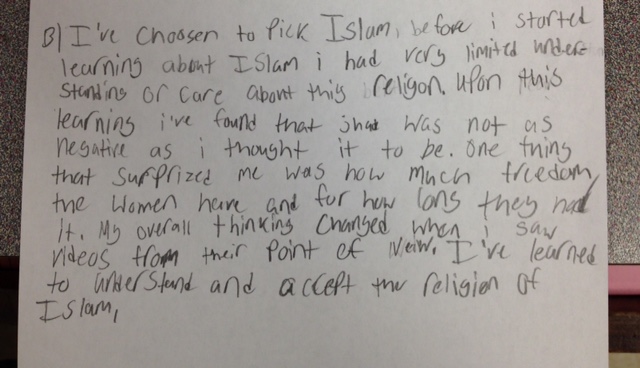As we head back into the school year and I think about one of my new roles, mentoring teachers online, I have been thinking alot about how one builds trust among the disparate groups of individuals that end up sitting in your classroom (or online mentee group). In an elective course like World Religions, the strings tying students to one another are much more tenuous–they are not necessarily all from the same grade or same social set, and you can’t even count on the fact that they all have a shared interest…remember it’s a high school elective course, which means some have been placed there just to fill a hole in their schedule. So what are some things you can do not just to build trust between you and the students, but between the students themselves?
- Icebreakers and name-games. I thought these were silly at first, but they are SO important. No one wants the moment (which I’ve had, sadly) during a class discussion when one students says, “Yes, I agree with….[awkward pause]…what’s your name again?” Come up with some silly name games and getting to know you activities (I like this list here) and use them frequently in the first few weeks, especially as kids are getting added and dropped from your class. They are worth the time–you have to know someone in order to trust them.
- Show vulnerability. As I wrote in this early post, religion is a sensitive topic and students need to know that diversity and differences of opinion and belief will be valued in your classroom. I tell a funny story about a religion that I made up as a child. You don’t have to do that, but I’d encourage you to share about your own experiences in a genuine way. Why do you like teaching this course? What are some silly mistakes you have made in the past? Showing students that you are not perfect (yet still an authority in your subject) is an important way to get them to view you as a caring human and not just a teacher-robot. Further, get them to share moments and questions with each other. One idea is to have students chat with a partner about questions they have regarding a topic before you discuss it as a class. Not only does this get them thinking about the subject, but it gets them to show one another that we all have something to learn.
- Create shared experiences. A “shared experience” can be as simple as an assignment that everyone does that you can refer back to often, but it can also be something more complex that they will distinctly remember. One of the activities I do early in the year to talk about the limits of archaeology as a mode of study is to mimic an “archaeological dig” by gathering strange objects in bags and placing students into “dig groups” to analyze what has been found. In their groups, students try to determine what the items (which are often just bizarre things I’ve found in my house–egg slicers, small statues, books in foreign languages) reveal about the society they come from. I also use this as a way to review the elements of religion that we discuss early on in the school year. The dig takes the better part of a class period, which may seem like a lot of class time for a “fun” activity, but it also serves as a reference point for future lessons, an experience that can be reflected on by all members of the class, and an opportunity to meet and talk with new people. Which leads me to my last point…
- Create groups and change them often. Teenagers are creatures of habit and they will work with the same people over and over and over. Sometimes this can be a good thing, but you are missing out on opportunities to improve the classroom dynamic AND improve learning. Especially at the beginning of a school year, I think it’s important for students to learn the names and quirks of the people around them, and you will may have to force those moments of interaction by assigning groups. This also allows you to create heterogenous or homogenous groups based on your goals for the lesson (I often differentiate by reading level using groups or think about the skills each student brings to the table). I frequently have intern teachers who feel they are being “mean” if they assign groups–not so! Rather, you are being intentional about the social and learning interactions that happen in your classroom, and giving students the opportunity to make a new friend! 🙂
Of course, this will change a bit for me as I figure out how to replicate these principles in an online environment. I’d love to hear any advice you may have! Good luck to all of you starting out your year in the classroom soon!
P.S. I’ve just started a store on Teachers Pay Teachers and will be uploading much of my World Religions content there. Yesterday I posted one of the icebreaker Bingo activities that I used. Feel free to check it out if you are interested!

